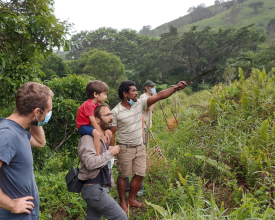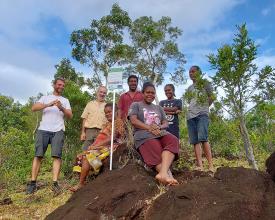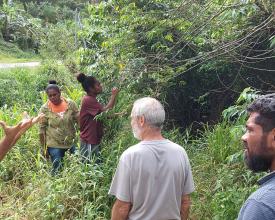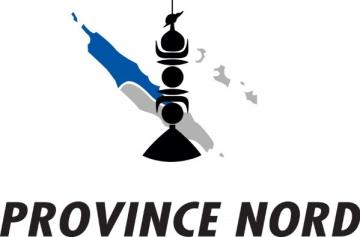
Testing new low-tech ecological restoration techniques within tribal communities in New Caledonia
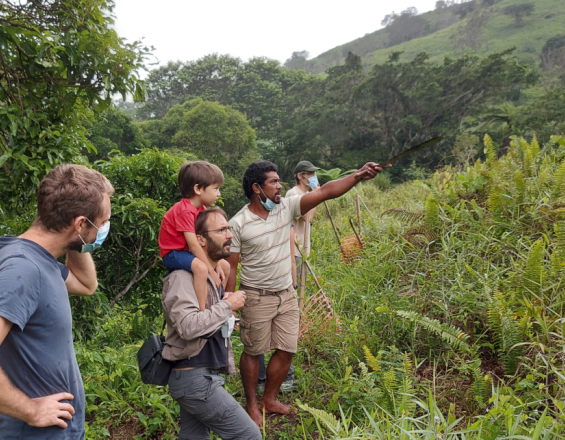
The project aimed to transfer the seed bombing technique developed by XGraines to the tribal communities of Poyes, Tiwae, and Vieux Touho, adapting it to the ecological context, specific site challenges, and the available local resources and manpower. The project sought to establish a complete cycle of production, seeding, and monitoring of results by:
-
Analyzing the ecological restoration challenges of the area.
-
Identifying the degraded target areas.
-
Identifying suitable plant species and their phenological schedule.
-
Researching and utilizing raw materials directly sourced from the site (clay, soil, etc.)
-
Purchasing equipment and making it available to the community.
-
Training community members as experts in the technique in all its aspects.
-
Establishing seedling sites.
-
Implementing a monitoring system to track progress.
-
Communicating and sharing results, inviting experts from other communities to learn about the initiative undertaken with the tribes of Poyes, Tiwae, and Vieux Touho.
Context
Challenges addressed
In the municipality of Touho, like many rural sites in New Caledonia, dense humid forests are declining, and the fragmentation of these forest ecosystems is leading to a loss of heritage and degradation of ecosystem services, particularly in terms of water quality. Fire and invasive species (deer) are the primary factors contributing to the degradation of the environment. Due to the slow forest dynamics, communities have undertaken forest restoration, particularly around drinking water catchments, using planting techniques. However, the implementation of traditional planting methods consumes significant resources (time, and finances). Therefore, new technical and organizational approaches have been tested.
Location
Process
Summary of the process
The diagnostic phase/building block comes first; the empowerment phase/building block is implemented afterwards.
Building Blocks
Carrying out a shared diagnosis for the selection of plant species and trial site selection.
One of the prerequisites for action was to work with the project referents in the tribe to conduct an inventory of potential sites for seed planting trials, as well as to identify and select certain target plant species necessary for the process. This step involved mobilizing specific expertise in ecology and botany, also traditional knowledge, as well as putting in place a validation process by the different levels of local authorities involved.
Enabling factors
Good communication with the local leaders in the tribes was a critical factor in completing this step. Project presentation ceremonies were held, followed by several field visits with ecological experts to list the range of possibilities and entrust the final choice of these trial sites to the local leaders. The project coordinators were flexible in adapting to the constraints of the location and human factors related to the desired modes of the organization by the local leaders.
Lesson learned
Remain flexible in the implementation of solutions; remain attentive to local community referents in order to arrive at a shared and agreed diagnosis and validate project options that local partners have appropriated.
Transfer of knowledge on new methods of ecological restoration through seeding
One of the main objectives of the project was to transfer the seed bombing method developed by XGraines, and adapting it to the material, human and knowledge resources available within tribal communities. This action required the implementation of several training workshops, following a preliminary phase of identification of all locally mobilizable resources. The experiments were carried out directly with the participants, who were able to contribute to the implementation of the method in a co-constructed process that could guarantee the proper appropriation of this technique. A main local referent was trained throughout the process and will be able to pass on this acquired knowledge in the future within the community.
Enabling factors
The tribe's representatives' interest in experimentation and their good understanding of the project's objectives is one of the main factors that favoured the project. The selection of participants who were already engaged in ecological restoration actions before the project demonstrates their commitment and willingness to improve and develop techniques in a field (reforestation and production) that is familiar to them.
Lesson learned
The transfer of knowledge and learning process required multiple workshops and work sessions.
Impacts
- Local communities have been empowered to implement a nature-based solution for biodiversity restoration: seed bombing.
- The relevance of seed bombing in the New Caledonian ecological and economic context has been demonstrated and its adoption has been encouraged.
- The local communities have been provided with new knowledge about ecological restoration, including plant species and techniques.
- A simple technique that can save time for individuals engaged in reforestation efforts and that requires less financial resources and time compared to traditional planting methods has been introduced.
Beneficiaries
Communities of the tribes of Poyes, Tiwae et Vieux Touho
Sustainable Development Goals
Story
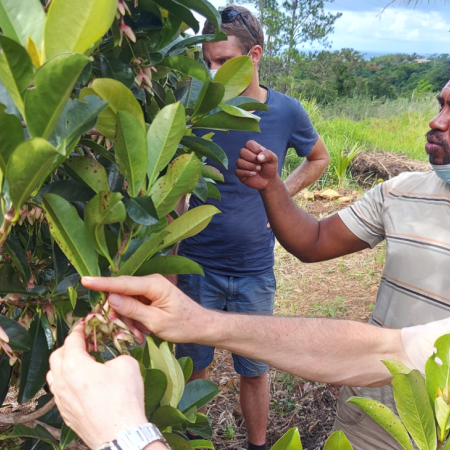
Aman is a resident of the Poyes tribe that participated in various stages of the project, benefiting from training in seed bomb production. During these exchanges, he contributed his knowledge of forest ecology to the project by citing tree species whose seeds he had seen germinate under particular natural conditions, thus providing indications of their potential use the seed bombing technique. During exchanges with the project's botanical expert, he also acquired new knowledge about certain species whose names and traditional uses had been lost in the area. Eventually, through this project, participants were able to mutually enrich their knowledge of forest ecology, the history of the landscape and natural ecosystems - from the time of their ancestors to recent changes - and deforestation, the effects of which are becoming increasingly visible.
